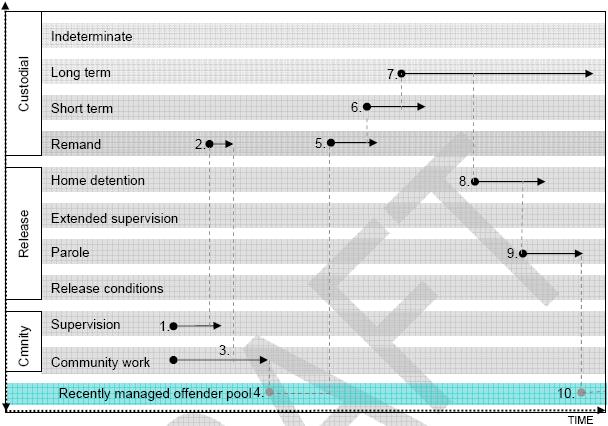11.2 Data enrichment and simplification
The new Offender-Major-Management-Period tables that are used as the basis of this report are the result of considerable enrichment and simplification of the underlying data available in the IOMS database.
The goal has been to provide a single unambiguous timeline for each offender's career describing the sequence of major management states to which the offender has been directed. The new data-set enforces a one-day/one-status requirement for each offender. This is a huge simplification compared to the complexity of the data and overlapping directives in the lives of some of the offenders. However it provides for a useful big picture analysis such that the numbers are self consistent and so that data issues can be identified and fixed.
To achieve the one-day/one-status requirement, a trumping process (see the major management categories in rank order ) has been introduced that provides the "major management category" in situations where the data says several things are happening simultaneously. It must be recognised that this means that exact alignment with many other Corrections' reports is difficult. For example a supervision sentence takes precedence over a contemporaneous community work sentence; a remand warrant takes precedence over a community sentence. In the timeline created the unmanaged periods between sentences and orders are also available for analysis, allowing the introduction of the concept of the "recently managed offenders' pool".
Concept diagram of directives issued and sequence of major management category
The diagram above represents all the different sentence and order directives recorded for a single offender. This representation demonstrates how these records can overlap in time and shows the hierarchy (on the vertical axis) applied to these records to produce a simplified non overlapping timeline. The simplified timeline below can be read in conjunction with the following key.
Offender timeline:
Timeline Key
This timeline is made up of distinct periods of management. By using the key one can represent both the management type (using line height) and offence category (using colour). Thus the offender above has had a period of supervision for drug offending, followed by remand, reverting to community work for burglary, "recently managed offender pool", remand, prison sentenced for violence, released on home detention (still to do with the violence), released on parole (still for the violence) and eventual return to the "recently managed offenders pool".
Examination of the timeline above demonstrates how it simplifies the data but with a trade off for some detail.



